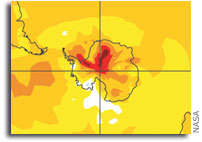NASA Study Shows Potential for Antarctic Climate Change

While Antarctica has mostly cooled over the last 30
years, the trend is likely to rapidly reverse, according to a
computer model study by NASA researchers. The study indicates
the South Polar Region is expected to warm during the next 50
years.
Findings from the study, conducted by researchers Drew
Shindell and Gavin Schmidt of NASA’s Goddard Institute of
Space Studies (GISS), New York, appeared in the Geophysical
Research Letters. Shindell and Schmidt found depleted ozone
levels and greenhouse gases are contributing to cooler South
Pole temperatures.
Low ozone levels in the stratosphere and increasing
greenhouse gases promote a positive phase of a shifting
atmospheric climate pattern in the Southern Hemisphere,
called the Southern Annular Mode (SAM). A positive SAM
isolates colder air in the Antarctic interior.
In the coming decades, ozone levels are expected to recover
due to international treaties that banned ozone-depleting
chemicals. Higher ozone in the stratosphere protects Earth’s
surface from harmful ultraviolet radiation. The study found
higher ozone levels might have a reverse impact on the SAM,
promoting a warming, negative phase. In this way, the effects
of ozone and greenhouse gases on the SAM may cancel each
other out in the future. This could nullify the SAM’s affects
and cause Antarctica to warm.
“Antarctica has been cooling, and one could argue some
regions could escape warming, but this study finds this is
not very likely,” Shindell said. “Global warming is expected
to dominate in future trends.”
The SAM, similar to the Arctic Oscillation or Northern
Annular Mode in the Northern Hemisphere, is a seesaw in
atmospheric pressure between the pole and the lower latitudes
over the Southern Ocean and the tip of South America.
These pressure shifts between positive and negative phases
speed-up and slow down the westerly winds that encircle
Antarctica. Since the late 1960s, the SAM has more and more
favored its positive phase, leading to stronger westerly
winds. These stronger westerly winds act as a kind of wall
that isolates cold Antarctic air from warmer air in the lower
latitudes, which leads to cooler temperatures.
Greenhouse gases and ozone depletion both lower temperatures
in the high latitude stratosphere. The cooling strengthens
the stratospheric whirling of westerly winds, which in turn
influences the westerly winds in the lower atmosphere.
According to the study, greenhouse gases and ozone have
contributed roughly equally in promoting a strong-wind,
positive SAM phase in the troposphere, the lowest part of the
atmosphere.
Shindell and Schmidt used the NASA GISS Climate Model to run
three sets of tests, each three times. For each scenario, the
three runs were averaged together. Scenarios included the
individual effects of greenhouse gases and ozone on the SAM,
and then a third run that examined the effects of the two
together.
The model included interactions between the oceans and
atmosphere. Each model run began in 1945 and extended through
2055. For the most part, the simulations matched well
compared with past observations.
Model inputs of increasing greenhouse gases were based upon
observations through 1999, and upon the Intergovernmental
Panel on Climate Change mid-range estimates of future
emissions. Stratospheric ozone changes were based on earlier
NASA GISS model runs that were found to be in good agreement
with past observations and similar to those found in other
chemistry-climate models for the future.
Shindell said the biggest long-term danger of global warming
in this region would be ice sheets melting and sliding into
the ocean. “If Antarctica really does warm up like this, then
we have to think seriously about what level of warming might
cause the ice sheets to break free and greatly increase
global sea levels,” he said.
In the Antarctic Peninsula, ice sheets as big as Rhode Island
have already collapsed into the ocean due to warming. The
warming in this area is at least partially a result of the
strengthened westerly winds that pass at latitudes of about
60 to 65 degrees south. As the peninsula sticks out from the
continent, these winds carry warm maritime air that heats the
peninsula. For information and images related to the research
on the Internet, visit:









